Abstract
The research reports broadband, continuous-wave (CW), mid-infrared generation based on an optical parametric oscillator (OPO), pumped by an amplified spontaneous emission (ASE) fiber source. The ASE fiber source has a ytterbium (Yb)-doped fiber master oscillator power amplifier (MOPA) structure. By injecting another fiber laser with high power and a narrow linewidth into the nonlinear crystal, the phase-matching difference frequency generation (DFG) can be realized at a low pumping threshold. It is shown that during the down-conversion of the ASE fiber source, the intracavity DFG can steadily and effectively generate a broadband mid-infrared laser, with a central wavelength of 3713 nm. The bandwidth of the mid-infrared laser is 122 nm. The pump power of 2 W generates a 0.238 W mid-infrared laser with a pump-idler conversion efficiency of 11.6%. It has tremendous application potential in the research of broadband CW mid-infrared lasers.
1. Introduction
Mid-infrared lasers play an indispensable role in many fields, such as space communication [1], medical applications [2], industrial processing [3], and military confrontation [4]. Different types of mid-infrared lasers have their advantages in performance, and the research generally focuses on developing lasers with higher power, higher efficiency, and even a wider spectral bandwidth [5,6,7,8,9]. The broadband mid-infrared laser can be absorbed by many gas molecules and has been used to monitor the concentration of various gas substances in the industry [10,11]. In addition, the broadband mid-infrared laser covers the absorption peaks of many specific functional groups of organic molecules and plays a significant role in biomedicine [12]. The 3–5 µm laser has attracted much attention in the mid-infrared wavelength due to its high air transmission rate [13]. Meanwhile, the absorption and emission characteristics of cobalt-doped II-VI gain media are in the 3–5 µm spectral region. There is excellent progress in their development, if a mid-infrared laser that is stable and broadband at room temperature is available as a pump source [14,15].
Nonlinear frequency conversion to generate broadband mid-infrared lasers is a widely available and effective technique, which mainly includes two methods. One method uses a femtosecond (fs) laser as a pumping source to generate a pulsed broadband mid-infrared laser [16,17]. Since the invention of photonic crystal fibers (PCFs) and the improved performance of pulsed fiber lasers, the development of supercontinuum has been very rapid, and the bandwidth of the resulting mid-infrared laser has been broadened with recent research [18]. The other method uses the CW source as a pumping source and realizes frequency down-conversion by OPO. In the CW-pumped OPO, the low nonlinear gain prevents the efficient utilization of optical parametric amplification (OPA) and optical parametric generation (OPG). Table 1 shows the recent developments in generating 3–4 μm CW mid-infrared lasers. The literature in the table shows that most of the research on 3–4 μm mid-infrared lasers in recent years has been directed towards higher power and higher efficiency, with little research on bandwidth. Therefore, the ability of CW laser-pumped OPO to generate broadband mid-infrared lasers has become one of the urgent challenges that needs to be solved.

Table 1.
Research on and development in 3–4 μm CW mid-infrared laser.
Broadband CW mid-infrared generation depends on a broad phase-matching bandwidth and high pump power. In 2009, Ritwick Das et al. used a CW ytterbium-doped (Yb-doped) fiber laser with a central wavelength of 1060 nm and a bandwidth of 76 nm to pump a singly resonant oscillator (SRO) [23]. When the pump power was 25.5 W, the idler beam with a maximum output power of 5.3 W and the full width at half maximum (FWHM) of 75 nm was obtained. The possible non-collinear phase under the condition of phase-matching was proposed. In 2011, J Storteboom et al. obtained an idler beam with a power of 1.4 W and a bandwidth of 230 nm, by pumping the OPO with an ASE fiber source with a pump power of 15.3 W and an FWHM of 15.2 nm [24]. In 2016, Shang et al. used an ASE source with a maximum power of 87.5 W and a bandwidth of 9 nm to pump the MgO: periodically poled lithium niobate (PPLN) OPO. The broadband mid-infrared laser was obtained with a central wavelength of 3325 nm, an FWHM of 72 nm, and maximum output power of 11.3 W [25]. In the research that uses the CW source as the pumping source to generate a broadband idler beam, the down-conversion process of the broadband pump source needs a large pumping bandwidth to realize the broadband phase-matching, and the broadband pump sources often have a high pumping threshold. Therefore, this paper further expands and discusses the experiment of ASE-pumped OPO and aims to acquire another scheme to generate broadband idler beams more efficiently and stably. In 2018, Wang Peng et al. used intracavity DFG in PPLN OPO to improve the conversion efficiency of 1080 nm lasers in the frequency down-conversion process, a new solution to generate CW mid-infrared lasers with low pump power [26]. Moreover, in the follow-up research [27], the intracavity DFG was further improved and optimized.
In this research, the intracavity DFG based on the ASE fiber source is realized in the PPLN OPO. The ASE fiber source has an FWHM of 11.8 nm, and it is injected into the PPLN OPO in parallel with a high-power, narrow-linewidth 1018 nm laser. By calculating the laser’s appropriate signal degenerate point and tuning the crystal’s polarization period, the phase-matched DFG is realized in the OPO cavity between the signal beam generated by the 1018 nm laser and the ASE source. The experimental result reveals that DFG occurred at 0.25 W. When the pump power is 2.04 W, among the two mid-infrared lasers generated by intracavity DFG, the bandwidth of an idler beam with a central wavelength of 3713 nm is 122 nm, which is the widest CW mid-infrared laser produced by nonlinear effects under low power conditions currently reported. The maximum mid-infrared laser power generated by the intracavity DFG is 238 mW, with a pump-idler conversion efficiency of 11.6%. The research further demonstrates the feasibility and effectiveness of a broadband CW mid-infrared laser using an ASE fiber source to perform intracavity DFG.
2. Experimental Setup and Methods
The optical path structure is shown in Figure 1. The 1018 nm laser is frequency-converted to generate a near-infrared signal beam through a MgO: PPLN. The ASE fiber source is combined with the 1018 nm laser by a wavelength division multiplexer (WDM) and enters the resonant cavity. DFG generates the mid-infrared idler beam with the signal beam in the PPLN. The ASE fiber source has a MOPA structure. The seed laser is a 1060 nm ASE source, with an FWHM of 23 nm and a maximum power of 100 mW. It passes through the isolator (ISO) 1 and is amplified in the power amplifier stage, which includes a (2 + 1) × 1 pump and signal combiner (PSC) and 11 m polarization-maintaining 10/125 μm Yb-doped optical fiber. Two 50 W 915 nm LDs are fused with two pump arms of the PSC. When the power of the seed source is set as 100 mW, the maximum power of the ASE source output from the amplifier is 2.04 W. The maximum output power of the 1018 nm laser is 46 W. The ASE source is connected to a 2 × 2 structure WDM (1018/1070 nm) after passing through ISO 2. As shown in Figure 1, port 1 and port 2 of the WDM are connected to two lasers, port 3 is connected to the OPO cavity, and port 4 is connected to OC2. A spectrometer is used to detect the spectral characteristics of the pump beam. The PPLN crystal used in the OPO resonator has a fan-shaped periodic structure. The OPO resonator is designed as a typical standing wave structure and consists of two curved mirrors M1 and M2, with a curvature radius of 150 mm. The output signal and residual pump beam are filtered by the structure of the mid-infrared descending mirror (0.9~1.8 μm) and germanium sheet. Power meter A records the remaining pump power, and power meter B records the signal power. In the subsequent experiment, the power and spectrum of the idler beam were recorded.
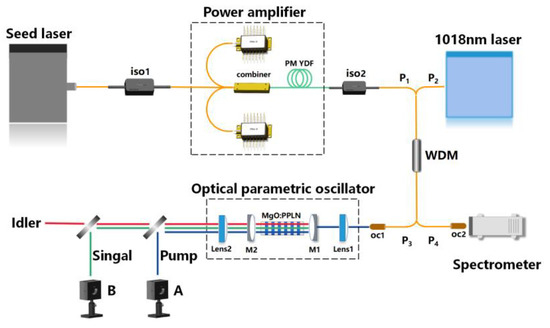
Figure 1.
Schematic diagram of broadband OPO intracavity difference frequency system.
The ASE pump source can provide more favorable conditions for broadband CW mid-infrared generation. However, the spectrum of ASE sources is associated with the phenomenon of wavelength drift and linewidth narrowing in the amplification process. In the power amplification of the ASE source, the absorption of the gain fiber will lead to the rapid narrowing of the bandwidth of the seed source. This phenomenon is mainly related to the length of the gain fiber, and the power amplifying process is only a small factor that narrows its bandwidth. Therefore, to ensure the spectrum’s stability and to set the pump bandwidth above 10 nm, the feasibility is studied in this paper, which includes lowering the pump threshold in the broadband phase-matching process under low pump power.
The spectrometer monitors the spectrum of the ASE seed source, as shown in Figure 2a. Its central wavelength is about 1060 nm, and the FWHM is 23 nm. The spectrum of the ASE seed source is relatively flat at 1040–1060 nm. The spectrum after first-level amplification is shown in Figure 2b. After the power amplification, the FWHM decreases to 11.8 nm, and the central wavelength shifts to 1073 nm. The appropriate signal degenerate point in the broadband phase-matching process is analyzed and calculated, and the idler bandwidth at the degenerate point is simulated.
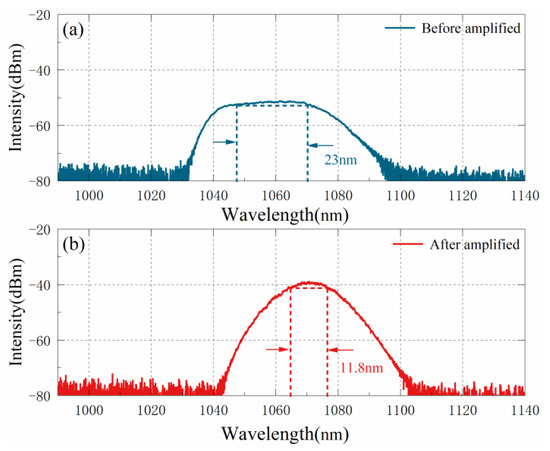
Figure 2.
The spectrum of ASE seed source and spectrum after power amplification.
According to the conservation formula of energy and momentum satisfied by the three wavelengths simultaneously, the appropriate crystal polarization period for the optical parametric oscillation of the 1018 nm laser and the DFG with the 1073 nm pump beam is simulated. It can be expressed in the form of the following equations:
where subscript p, s, and i represent the pump, signal, and idler beam, respectively, λp1 is the central wavelength of the 1018 nm laser, and λp2 is the central wavelength of the ASE source. Δk is the phase-mismatching, and ʌ is the polarization period of the crystal. np, ns, ni are the refractive indices of the pump, signal, and idler beam in the PPLN crystal, respectively, which are functions of temperature and wavelength, also known as the Sellmeier equation [28].
The parameters a1 to a6 and b1 to b4 in the formula equal 5.756, 0.0983, 0.202, 189.32, 12.52, 0.0132, 2.86 × 10−6, 4.7 × 10−8, 6.113 × 10−8, 1.516 × 10−4, respectively, and the experimental temperature T is set as 25 °C.
As shown in Figure 3, in the tuning curves of the 1018 nm and 1073 nm lasers, the phase-matched point is obtained when the crystal grating period is 29.69. The signal beam generated by the OPO is degraded at 1.493 μm, and the phase-matched DFG is generated between the signal beam generated by the 1073 nm and 1018 nm lasers. The phase-matched bandwidth of the ASE source in the frequency conversion process is calculated. For the injected pump beam, the phase-mismatched can be expanded into a series at the central wavelength λ0 [23], as shown by the following equation:
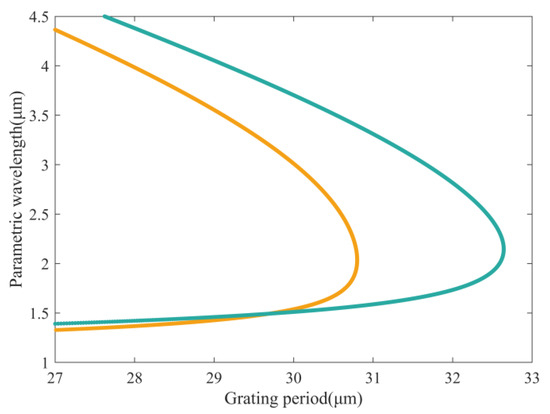
Figure 3.
Tuning of the crystal grating period.
The first term on the right side of the equation is 0 in the case of phase-matching, which is mainly determined by the second and higher order terms. The second term is group velocity mismatch (GVM), which generally does not equal zero. The value of the higher-order term in the equation is much smaller than the second term. The broadband phase-matching condition can also be explained by the difference frequency theory to some extent, citing the DFG conversion efficiency in Ref. [29], based on the assumption of a reference Gaussian input beam.
p is the beam power, L is the crystal length, ω is the angular frequency, deff is the effective nonlinear coefficient, k is the wave vector, c is the speed of light in vacuum, ε0 is the free space permittivity, n is the refractive index, h(μ,ξ) is the focusing parameter, which is a constant value. In this study, the phase mismatch amount Δk in Equation (6) is taken into account, and the relationship between the idler power and the pump bandwidth can be obtained as follows:
The pump source with the central wavelength at 1073 nm can be substituted into Equation (8). When the DFG conversion efficiency is the highest, the ASE pump source with a bandwidth of 12 nm can generate an idler beam output with a central wavelength of 3.71 μm and a bandwidth of 100 nm, as shown in Figure 4.
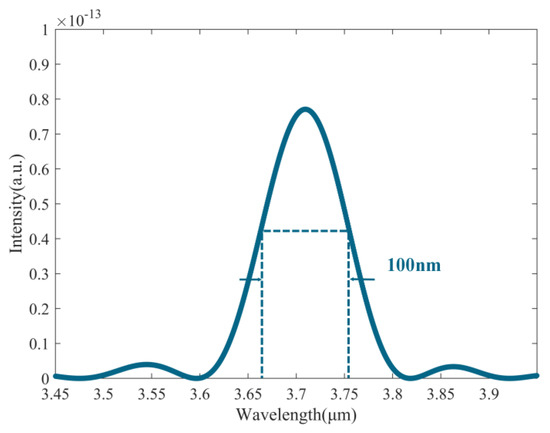
Figure 4.
Simulated DFG idler spectrum.
In the above simulation, it has been proven that the experimental device of the intracavity DFG of the ASE fiber source meets the experimental requirements, and when combined with the simulation results, the intracavity DFG of the ASE fiber source can be carried out.
3. Results and Discussion
The mid-infrared dichroic mirror filters out the idler beam generated by the 1018 nm pumped OPO in the mid-infrared generation. It was found that the idler beams generated by the intracavity DFG in different grating periods have different bandwidths. Figure 5 shows the idler spectrum generated by the intracavity DFG of the ASE source under different types of phase-mismatching.
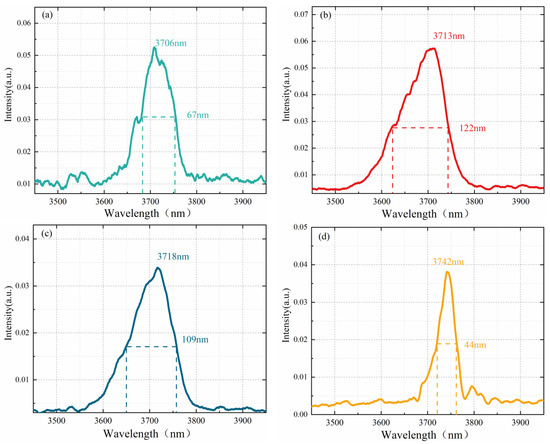
Figure 5.
DFG idler spectrum under different types of phase-mismatching with different central wavelengths at (a) 3706 nm; (b) 3713 nm; (c) 3718 nm; (d) 3742 nm.
When the Δk is different, the central wavelength is located at the DFG idler beams of 3706 nm, 3713 nm, 3718 nm, and 3742 nm. When the center wavelength is located at 3706 nm and 3742 nm, the DFG idler bandwidth is only 67 nm and 44 nm. It shows that the DFG process is phase-mismatched at this time. The signal beams generated by the ASE source and the 1018 nm laser can only undergo phase-mismatched DFG when the non-signal beam degenerates. Although the DFG mid-infrared laser will be generated, the bandwidth cannot reach the maximum value generated when the phase-matching is satisfied in the broadband phase-matching calculation.
When Δk approaches 0, the broadband idler beam with a bandwidth of 109 nm is generated, as shown in Figure 5c. The idler beam with the central wavelength at 3718 nm is not at the broadband phase-matching point calculated in the simulation. The phase-mismatched is 0.00027, and the broadband phase matching process can be optimized to generate a wider bandwidth. With further tuning of the MgO: PPLN crystal, the broadband DFG process generates an idler beam with a bandwidth of 122 nm when the central wavelength is located at 3713 nm, which is the widest idler bandwidth generated by the currently reported broadband CW source under low pumping power and room temperature conditions.
The 1018 nm laser is turned on and the power is increased to 46 W. After the signal beam forms a stable oscillation in the cavity, the ASE source is turned on. Figure 6 shows the pump and idler power curve and the pump–idler conversion efficiency curve. When the pump power is 0.25 W, the DFG process can take place, and the idler power is 28.7 mW. As the pump power is increased from 0.25 W to 2.04 W, the DFG idler power is increased to 238 mW, and the conversion efficiency is maintained at 11.4–11.8%, as shown by the pump–idler conversion efficiency curve.

Figure 6.
Measured 3713 nm broadband idler power and pump–idler conversion efficiency.
4. Conclusions
This paper realized the down-conversion process of a broadband CW source at room temperature and a low pumping threshold based on intracavity DFG. The ASE fiber source and the narrow linewidth 1018 nm laser are injected into the OPO in parallel. The polarization period tuning in the fan-shaped crystal impacts the signal beam, and the broadband CW idler beam is obtained with a low pumping threshold. When the pump power was 2.04 W, an idler beam with a power of 0.238 W and a bandwidth of 122 nm was generated, and the pump-idler conversion efficiency was 11.6%. Through broadband phase-matching, it is also proven that the broadband CW source can be down-converted under a low pumping threshold to generate a broadband mid-infrared laser.
Author Contributions
Conceptualization, X.L. and P.W.; methodology, X.L.; software, K.W. and P.W.; validation, X.L., W.H. and K.W.; formal analysis, W.H.; investigation, Z.W.; resources, W.H.; data curation, X.L.; writing—original draft preparation, K.W; writing—review and editing, K.W., P.W., W.H. and X.L.; visualization, Z.W.; supervision, W.H.; project administration, K.H.; funding acquisition, W.H. All authors have read and agreed to the published version of the manuscript.
Funding
This research was funded by the National Natural Science Foundation of China (Grant No. 61975236) and Project 2019-JCJQ-JJ-202.
Data Availability Statement
Data underlying the results presented in this paper are not publicly available at this time but may be obtained from the authors upon reasonable request.
Acknowledgments
The authors thank Nanjing University, Zhejiang University, and Fujian Institute of Research on the Structure for their offer of nonlinear crystals.
Conflicts of Interest
The authors declare no conflict of interest.
References
- Pang, X.; Schatz, R.; Joharifar, M.; Udalcovs, A.; Bobrovs, V.; Zhang, L.; Yu, X.; Sun, Y.-T.; Maisons, G.; Carras, M.; et al. Direct Modulation and Free-Space Transmissions of up to 6 Gbps Multilevel Signals With a 4.65 μm Quantum Cascade Laser at Room Temperature. J. Lightwave Technol. 2022, 40, 2370–2377. [Google Scholar] [CrossRef]
- Toor, F.; Jackson, S.; Shang, X.; Arafin, S.; Yang, H. Mid-Infrared Lasers for Medical Applications: Introduction to the Feature Issue. Biomed. Opt. Express 2018, 9, 6255. [Google Scholar] [CrossRef]
- Ren, T.; Wu, C.; Yu, Y.; Dai, T.; Chen, F.; Pan, Q. Development Progress of 3–5 μm Mid-Infrared Lasers: OPO, Solid-State and Fiber Laser. Appl. Sci. 2021, 11, 11451. [Google Scholar] [CrossRef]
- Abramov, P.I.; Kuznetsov, E.V.; Skvortsov, L.A. Prospects of Using Quantum-Cascade Lasers in Optoelectronic Countermeasure Systems: Review. J. Opt. Technol. 2017, 84, 331. [Google Scholar] [CrossRef]
- Hu, C.; Chen, T.; Jiang, P.; Wu, B.; Su, J.; Shen, Y. Broadband High-Power Mid-IR Femtosecond Pulse Generation from an Ytterbium-Doped Fiber Laser Pumped Optical Parametric Amplifier. Opt. Lett. 2015, 40, 5774. [Google Scholar] [CrossRef] [PubMed]
- Ycas, G.; Giorgetta, F.R.; Baumann, E.; Coddington, I.; Herman, D.; Diddams, S.A.; Newbury, N.R. High-Coherence Mid-Infrared Dual-Comb Spectroscopy Spanning 2.6 to 5.2 μm. Nat. Photon. 2018, 12, 202–208. [Google Scholar] [CrossRef]
- Wu, H.; Wang, W.; Li, Y.; Li, C.; Yao, J.; Wang, Z.; Liang, H. Difference-Frequency Generation of Random Fiber Lasers for Broadly Tunable Mid-Infrared Continuous-Wave Random Lasing Generation. J. Lightwave Technol. 2022, 40, 2965–2970. [Google Scholar] [CrossRef]
- Swiderski, J.; Michalska, M.; Grzes, P. Broadband and Top-Flat Mid-Infrared Supercontinuum Generation with 3.52 W Time-Averaged Power in a ZBLAN Fiber Directly Pumped by a 2 μm Mode-Locked Fiber Laser and Amplifier. Appl. Phys. B 2018, 124, 152. [Google Scholar] [CrossRef]
- Turner, E.J.; Evans, J.W.; Harris, T.R.; McDaniel, S.A. Double-Pass Co:CdTe Mid-Infrared Laser Amplifier. Opt. Mater. Express 2018, 8, 2948. [Google Scholar] [CrossRef]
- Lamard, L.; Balslev-Harder, D.; Peremans, A.; Petersen, J.C.; Lassen, M. Versatile Photoacoustic Spectrometer Based on a Mid-Infrared Pulsed Optical Parametric Oscillator. Appl. Opt. 2019, 58, 250. [Google Scholar] [CrossRef]
- Fjodorow, P.; Frolov, M.P.; Korostelin, Y.V.; Kozlovsky, V.I.; Schulz, C.; Leonov, S.O.; Skasyrsky, Y.K. Room-Temperature Fe:ZnSe Laser Tunable in the Spectral Range of 3.7–5.3 μm Applied for Intracavity Absorption Spectroscopy of CO2 Isotopes, CO and N2O. Opt. Express 2021, 29, 12033. [Google Scholar] [CrossRef] [PubMed]
- Dabrowska, A.; David, M.; Freitag, S.; Andrews, A.M.; Strasser, G.; Hinkov, B.; Schwaighofer, A.; Lendl, B. Broadband Laser-Based Mid-Infrared Spectroscopy Employing a Quantum Cascade Detector for Milk Protein Analysis. Sens. Actuators B Chem. 2022, 350, 130873. [Google Scholar] [CrossRef]
- Zuo, Z.; Gu, C.; Peng, D.; Zou, X.; Di, Y.; Zhou, L.; Luo, D.; Liu, Y.; Li, W. Broadband Mid-Infrared Molecular Spectroscopy Based on Passive Coherent Optical–Optical Modulated Frequency Combs. Photon. Res. 2021, 9, 1358. [Google Scholar] [CrossRef]
- Xu, L.; Li, Y.; Ju, Y. 91.1 kW, 5.3 ns Compact Mid-Infrared Optical Parametric Amplification Based on PPMgLN. Results Phys. 2019, 15, 102783. [Google Scholar] [CrossRef]
- Mirov, S.B.; Fedorov, V.V.; Martyshkin, D.; Moskalev, I.S.; Mirov, M.; Vasilyev, S. Progress in Mid-IR Lasers Based on Cr and Fe-Doped II–VI Chalcogenides. IEEE J. Select. Top. Quantum Electron. 2015, 21, 292–310. [Google Scholar] [CrossRef]
- Chen, K.; Liu, S.; Zhang, B.; Gong, Z.; Chen, Y.; Zhang, M.; Deng, H.; Guo, M.; Ma, F.; Zhu, F.; et al. Highly Sensitive Photoacoustic Multi-Gas Analyzer Combined with Mid-Infrared Broadband Source and near-Infrared Laser. Opt. Lasers Eng. 2020, 124, 105844. [Google Scholar] [CrossRef]
- Täschler, P.; Bertrand, M.; Schneider, B.; Singleton, M.; Jouy, P.; Kapsalidis, F.; Beck, M.; Faist, J. Femtosecond Pulses from a Mid-Infrared Quantum Cascade Laser. Nat. Photon. 2021, 15, 919–924. [Google Scholar] [CrossRef]
- Wang, Z.; Zhang, B.; Liu, J.; Song, Y.; Zhang, H. Recent Developments in Mid-Infrared Fiber Lasers: Status and Challenges. Opt. Laser Technol. 2020, 132, 106497. [Google Scholar] [CrossRef]
- Zhao, J.; Cheng, P.; Xu, F.; Zhou, X.; Tang, J.; Liu, Y.; Wang, G. Watt-Level Continuous-Wave Single-Frequency Mid-Infrared Optical Parametric Oscillator Based on MgO:PPLN at 3.68 μm. Appl. Sci. 2018, 8, 1345. [Google Scholar] [CrossRef]
- Xu, M.; Yu, F.; Hassan, M.R.A.; Knight, J.C. Continuous-Wave Mid-Infrared Gas Fiber Lasers. IEEE J. Select. Topics Quantum Electron. 2018, 24, 0902308. [Google Scholar] [CrossRef]
- Xi, C.; Wang, P.; Li, X.; Liu, Z. Highly Efficient Continuous-Wave Mid-Infrared Generation Based on Intracavity Difference Frequency Mixing. High Power Laser Sci. Eng. 2019, 7, e67. [Google Scholar] [CrossRef]
- Luo, H.-Y.; Wang, Y.-Z. Linearly Polarized Polarization-Maintaining Er3+-Doped Fluoride Fiber Laser in the Mid-Infrared. J. Electron. Sci. Technol. 2022, 20, 100147. [Google Scholar] [CrossRef]
- Das, R.; Kumar, S.C.; Samanta, G.K.; Ebrahim-Zadeh, M. Broadband, High-Power, Continuous-Wave, Mid-Infrared Source Using Extended Phase-Matching Bandwidth in MgO:PPLN. Opt. Lett. 2009, 34, 3836. [Google Scholar] [CrossRef]
- Storteboom, J.; Lee, C.J.; Nieuwenhuis, A.F.; Lindsay, I.D.; Boller, K.-J. Incoherently Pumped Continuous Wave Optical Parametric Oscillator Broadened by Non-Collinear Phasematching. Opt. Express 2011, 19, 21786. [Google Scholar] [CrossRef] [PubMed]
- Shang, Y.; Xu, J.; Wang, P.; Li, X.; Zhou, P.; Xu, X. Ultra-Stable High-Power Mid-Infrared Optical Parametric Oscillator Pumped by a Super-Fluorescent Fiber Source. Opt. Express 2016, 24, 21684. [Google Scholar] [CrossRef] [PubMed]
- Wang, P.; Cheng, X.; Li, X.; Xu, X.; Han, K.; Chen, J. Dual-Wavelength Mid-Infrared Generation Using Intracavity Stimulated Raman Scattering of PPLN. IEEE Photonics J. 2018, 10, 1504408. [Google Scholar] [CrossRef]
- Feng, J.; Cheng, X.; Li, X.; Wang, P.; Hua, W.; Han, K. Highly Efficient Mid-Infrared Generation from Low-Power Single-Frequency Fiber Laser Using Phase-Matched Intracavity Difference Frequency Mixing. Appl. Sci. 2020, 10, 7454. [Google Scholar] [CrossRef]
- Paul, O.; Quosig, A.; Bauer, T.; Nittmann, M.; Bartschke, J.; Anstett, G.; L’huillier, J.A. Temperature-Dependent Sellmeier Equation in the MIR for the Extraordinary Refractive Index of 5% MgO Doped Congruent LiNbO3. Appl. Phys. B 2006, 86, 111–115. [Google Scholar] [CrossRef]
- Yanagawa, T.; Kanbara, H.; Tadanaga, O.; Asobe, M.; Suzuki, H.; Yumoto, J. Broadband Difference Frequency Generation around Phase-Match Singularity. Appl. Phys. Lett. 2005, 86, 161106. [Google Scholar] [CrossRef]
Publisher’s Note: MDPI stays neutral with regard to jurisdictional claims in published maps and institutional affiliations. |
© 2022 by the authors. Licensee MDPI, Basel, Switzerland. This article is an open access article distributed under the terms and conditions of the Creative Commons Attribution (CC BY) license (https://creativecommons.org/licenses/by/4.0/).